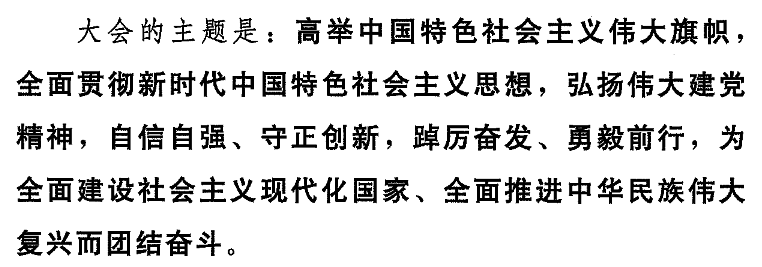
Mapping the Work Report to the 20th CPC National Congress
Larry Catá Backer, for Coalition for Peace & Ethics 19 October 2022
Downloadable version here
Weighing in at about 72 pages in its original Chinese (and inexplicably) a shorter 63 pages in its unofficial English translation, the Work Report delivered to the 20th National Congress of the CPC by its general secretary, is a monumental project to digest. As an object, of course, it is meant to serve as a metaphor for the state, the enterprise of government and the role and talent of the CPC in building this massive object//Work Report, Party, State, Society, Global leader.
But the Work Report is more than a semiotic object, the firstness of which—as an hours long read or a massive ecology of text—belies its signification (as the bedrock for leadership and guidance), and its role in rationalizing the universe within which it is only possible to function in China and with the Chinese apparatus (and through it, Chinese economic, social, cultural and political collectives). This is not because it must invariably be so, but because it has been caused to be so by the assertion of leadership of the societal vanguard organized in a Communist Party for China.
As such, it is important to read the Work Report for its effort to synthesize that reality ordering of the vanguard. That effort yields benefits for the reader, if only to acquire a sense of the vocabulary, and the structures of thought and the language through which reality is rationalized, and thus rationalized framed and constrained. This is the cage–not of regulation–but of the premises and orderings of the mind on the basis of which key actors and institutions see and respond to the world around them.
To make that a little easier, it may be useful to map the Work Report to the 20th CPC National Congress. The object is not to summarize but to develop expose the structure within which the discursive project of the Work Report is organized.
The Map
The Work Report is organized in – Parts. These follow a brief 2 paragraph chapeau that introduces the Work Report theme: (1) holding high the great banner of socialism with Chinese characteristics, (2) fully implementing the Thought on Socialism with Chinese Characteristics for a New Era, carrying forward the great founding spirit of the Party, (3) staying confident and building strength, (4) upholding fundamental principles and breaking new ground, (5) forging ahead with enterprise and fortitude, and striving in unity to build a modern socialist country in all respects and advance the great rejuvenation of the Chinese nation on all fronts.

The theme itself was built, crucially, on a very specific view of the consequences of the Reform and Opening Up period as leading state and Party top an inflection point (Work Report, English version pp. 4-5):
“A decade ago this was the situation we faced: Great achievements had been secured in reform, opening up, and socialist modernization, and notable advances had been made in the great new project of Party building. All this had created solid foundations, favorable conditions, and key underpinnings for our continued progress. At the same time, however, a number of prominent issues and problems-some of which had been building for years and others which were just emerging- demanded urgent action.”
“Inside the Party, there were many issues with respect to upholding the Party’s leadership, including a lack of clear understanding and effective action as well as a slide toward weak, hollow, and watered-down Party leadership in practice. Some Party members and officials were wavering in their political conviction. Despite repeated warnings, pointless formalities, bureaucratism, hedonism, and extravagance persisted in some localities and departments. Privilege-seeking mindsets and practices posed a serious problem, and some deeply shocking cases of corruption had been uncovered.”
“China’s economy was beset by acute structural and institutional problems. Development was imbalanced, uncoordinated, and unsustainable, and the traditional development model could no longer keep us moving forward. Some deep-seated problems in institutions and barriers built by vested interests were becoming more and more apparent. Some people lacked confidence in the socialist political system with Chinese characteristics, and, all too often, we saw laws being ignored or not being strictly enforced. Misguided patterns of thinking such as money worship, hedonism, egocentricity, and historical nihilism were common, and online discourse was rife with disorder. “
“All this had a grave impact on people’s thinking and the public opinion environment. Our work to ensure the people’s wellbeing was fraught with weak links. Tightening resource and environmental constraints and environmental pollution were pronounced. The systems for safeguarding national security were inadequate, and our capacity for responding to various major risks was insufficient. Many shortcomings were affecting the modernization of national defense and the military. The institutions and mechanisms for implementing the policy of One Country, Two Systems in Hong Kong and Macao were not well-developed, and China faced grave challenges to its national security. These were just some of the problems we faced. Back then, many people, both in and outside of our Party, were worried about the future of the Party and the country.”
This serves as the foundation, and the lens through which, everything that follows is built and understood. In some ways, it is this now official reconstruction of the state of the nation and the Party on the eve of the leadership of Xi Jinping, that is probably the most significant contribution to new era thinking. Its semiotics is unavoidable as well. Meaning making is now a function of this construction of the lifeworld that is China and with it the normative basis for judging the “before” and “after “.
With that firmly established, the rest of the Work Report is divided into the following Sections and sub-sections:
(I) “The Work of the Past Five Years and the Great Changes in the First Decade of the New Era;
This section contains no numbered subparts but it highlights the following 16 points that acquire significance when understood against the chaos and failures of the immediately preceding period marking the end of the Era of Reform and Opening Up:
–We have established the Thought on Socialism with Chinese Characteristics for a New Era:
–We have strengthened the Party leadership in all respects;
–We have developed well-conceived and complete strategic plans for advancing the cause of the Party and the country in the new era;
–We have achieved moderate prosperity, the millennia-old dream of the Chinese nation, through persistent hard work;
–We have put forward and applied a new development philosophy, worked hard to promote high-quality development, and pushed to foster a new pattern of development;
–We have comprehensively deepened reform with tremendous political courage;
–We have pursued a more proactive strategy of opening up;
–We have kept to the path of socialist political advancement with Chinese characteristics;
–We have established and upheld a foundational system for ensuring the guiding role of Marxism in the ideological domain;
–We have implemented a people-centered philosophy of development;
–We have acted on the idea that lucid waters and lush mountains are invaluable assets;
–We have applied a holistic approach to national security;
–We have set the Party’s goal of building a strong military in the new era;
–We have fully and faithfully implemented the policy of One Country, Two Systems.
–We have pursued major-country diplomacy with Chinese characteristics on all fronts
–We have made significant advances in exercising full and rigorous Party self-governance:
(II) “A New Frontier in Adapting Marxism to the Chinese Context and the Needs of the Times;”
This section also contains no numbered subparts but it organizes the central theme of the section—ideological flexibility and innovation—into a number of ordering insights:
–We must put the people first;
–We must maintain self-confidence and stand on our own feet;
–We must uphold fundamental principles and break new ground;
–We must adopt a problem oriented approach;
–We must apply systems thinking;
–We must maintain a global vision.
(III) “The New Journey of the New Era: Missions and Tasks of the Communist Party of China;”
This section focuses on the key issue of the transformation of socialist modernization as the bedrock principle of Leninism with Chinese characteristics. It redraws socialist modernization along the following lines:
–It is modernization of a huge population;
–It is the modernization of common prosperity for all;
–It is the modernization of material and cultural-ethical advancement;
–It is the modernization of harmony between humanity and nature;
–It is the modernization of peaceful development;
It consolidates the Basic Line of the PCP within the framework of modernization:
The essential requirements of Chinese modernization are as follows: upholding the leadership of the Communist Party of China and socialism with Chinese characteristics, pursuing high-quality development, developing whole-process people’s democracy, enriching the people’s cultural lives, achieving common prosperity for all, promoting harmony between humanity and nature, building a human community with a shared future, and creating a new form of human advancement. (Work Report (English version), p. 19). These are then organized in the following categories:
–Upholding and strengthening the Part’s overall leadership;
–Following the path of socialism with Chinese characteristics;
–Applying a people centered development philosophy;
–Remaining committed to deepening reform and opening up;
–Carrying forward our fighting spirit.
(IV) “Accelerating the Creation of a New Development Pattern and Pursuing High-Quality Development;”
Development is the operational centerpiece of the Work Report and mirroring the dual circulation policy has an internal and external component (Work Report (English version), 23). It is organized in the following sub-sections:
–Building a high standard socialist market economy
–Modernizing the industrial system;
–Advancing rural revitalization across the board;
–Promoting coordinated regional development;
–Promoting high standard opening up.
(V) “Invigorating China through Science and Education and Developing a Strong Workforce for the Modernization Drive;”
The section organizes the task of education and the management of mass capacity along the following sub-parts:
–Developing education that meets the people’s expectations;
–Improving systems for scientific and technological innovation:
–Accelerating the implementation of the innovation-driven development strategy;
–Implementing the workforce development strategy.
(VI) “Advancing Whole-Process People’s Democracy and Ensuring that the People Run the Country;”
This is a key area of innovation, now understood as an aspect of new era socialist modernization. It’s exposition is divided into the following sub-sections which elaborate the essence of the project:
–Strengthening the institutions through which the people run the country;
–Fully developing consultative democracy;
–Actively developing democracy at the primary level;
–Consolidating and developing the broadest possible patriotic united front.
(VII) “Exercising Law-Based Governance on All Fronts and Advancing the Rule of Law in China;”
This portion of the Work Report elaborates a long term project of the CPC, to “follow a path of socialist rule of law with Chinese characteristics, develop a Chinese system of socialist rule of law, and establish China as a socialist country under the rule of law.” (Work Report (English version) p. 34). It is organized into the following subsections:
–Improving the socialist legal system with Chinese characteristics with the Constitution at its core:
–Steadily advancing law-based government administration;
–Ensuring strict and impartial administration of justice:
–Stepping up efforts to establish the rule of law throughout society.
(VIII) “Building Cultural Confidence and Strength and Securing New Successes in Developing Socialist Culture;”
Cultural development is understood now as an essential element of socialist modernization. That task is organized in the following sub-sections:
1. Developing a socialist ideology that has the power to unite and inspire the people;
2. Extensively applying core socialist values;
3. Enhancing civility throughout society;
4. Developing cultural programs and the cultural sector;
5. Extending the reach and appeal of Chinese civilization.
(IX) “Improving the People’s Wellbeing and Raising Quality of Life;”
This section is devoted to the practical means for meeting the challenge of the primary contradiction of the new era—uneven distribution and is organized as follows:
1. Improving the system of income distribution;
2. Implementing the employment-first strategy;
3. Improving the social security system;
4. Advancing the Healthy China Initiative.
(X) Pursuing Green Development and Promoting Harmony between Humanity and Nature;”
New Era socialist modernization is meant to be sustainable. To that ends the Work Report consolidates and refines the environmental programs of prior Congress Work Reports along the following lines:
1. Accelerating the transition to a model of green development;
2. Intensifying pollution prevention and control;
3. Enhancing diversity, stability, and sustainability in our ecosystems;
4. Working actively and prudently toward the goals of reaching peak carbon emissions and carbon neutrality.
(XI) “Modernizing China’s National Security System and Capacity and Safeguarding National Security and Social Stability;”
The Work Report centers national security as the fundamental ordering principle underlying dual circulation strategies, as a means of protecting socialist modernization, and the integrity of the state and its ideological system. “National security is the bedrock of national rejuvenation, and social stability is a prerequisite for building a strong and prosperous China. We must resolutely pursue a holistic approach to national security and promote national security in all areas and stages of the work of the Party and the
country, so as to ensure national security and social stability.” (Work Report (English version) p. 45). It is organized in the following sub-sections:
1. Improving the national security system;
2. Strengthening our capacity for safeguarding national security;
3. Enhancing public safety governance;
4. Improving the social governance system.
(XII) “Achieving the Centenary Goal of the People’s Liberation Army and Further Modernizing National Defense and the Military:”
The constitution of the military as an arm and articulation of ideological authority under the CPC is stressed. “ We will continue to enhance political loyalty in the military, strengthen the military through reform, science and technology, and personnel training, and run the military in accordance with the law.” (Work Report (English version) p. 47).
(XIII) “Upholding and Improving the Policy of One Country, Two Systems and Promoting National Reunification;”
Two points serve as the core of this section:
–“We will inspire more people in Hong Kong and Macao to love both the country and their own regions, be more patriotic, and forge a broader united front at home and abroad in support of the One Country, Two Systems policy. We will crack down hard on anti-China elements who attempt to create chaos in Hong Kong and Macao. We will take resolute action to prevent and stop interference in the affairs of Hong Kong and Macao by external forces.”” (Work Report (English version) p. 51).
–“Taiwan is China’s Taiwan. Resolving the Taiwan question is a matter for the Chinese, a mater that must be resolved by the Chinese. We will continue to strive for peaceful reunification with the greatest sincerity and the utmost effort, but we will never promise to renounce the use of force, and we reserve the option of taking all measures necessary. This is directed solely at interference by outside forces and the few separatists seeking ‘Taiwan independence’ and their separatist activities.” (Work Report (English version) p. 52),
(XIV) “Promoting World Peace and Development and Building a Human Community with a Shared Future;”
This section summarizes, briefly, the now well established position of Chinese internationalist policy. “For its part, China has always been committed to its foreign policy goals of upholding world peace and promoting common development, and it is dedicated to promoting a human community with a shared future.” (Work Report (English version) p. 55).
(XV) “Exercising Full and Rigorous Self-Governance and Advancing the Great New Project of Party Building in the New Era;”
Party building remains at the center of the Work Report, and like the General Program of the Chinese Communist Party Constitution, it takes up the last section of the Work Report. It is organized into the following sub-sections that have thereafter been essentialized and widely distributed in summary form:
1. Upholding and strengthening the centralized, unified leadership of the Party Central Committee;
2. Enhancing cohesion and forging the Party’s soul with the Thought on Socialism with Chinese Characteristics for a New Era;
3. Improving the systems and regulations for the Party’s self-reform;
4. Cultivating officials capable of shouldering the mission of national rejuvenation;
5 . Enhancing the political and organizational functions of Party organizations;
6. Taking strict steps to improve Party conduct and enforce Party discipline;
7. Winning the tough and protracted battle against corruption.
The Work Report ends with a 9 paragraph set of closing thoughts.


